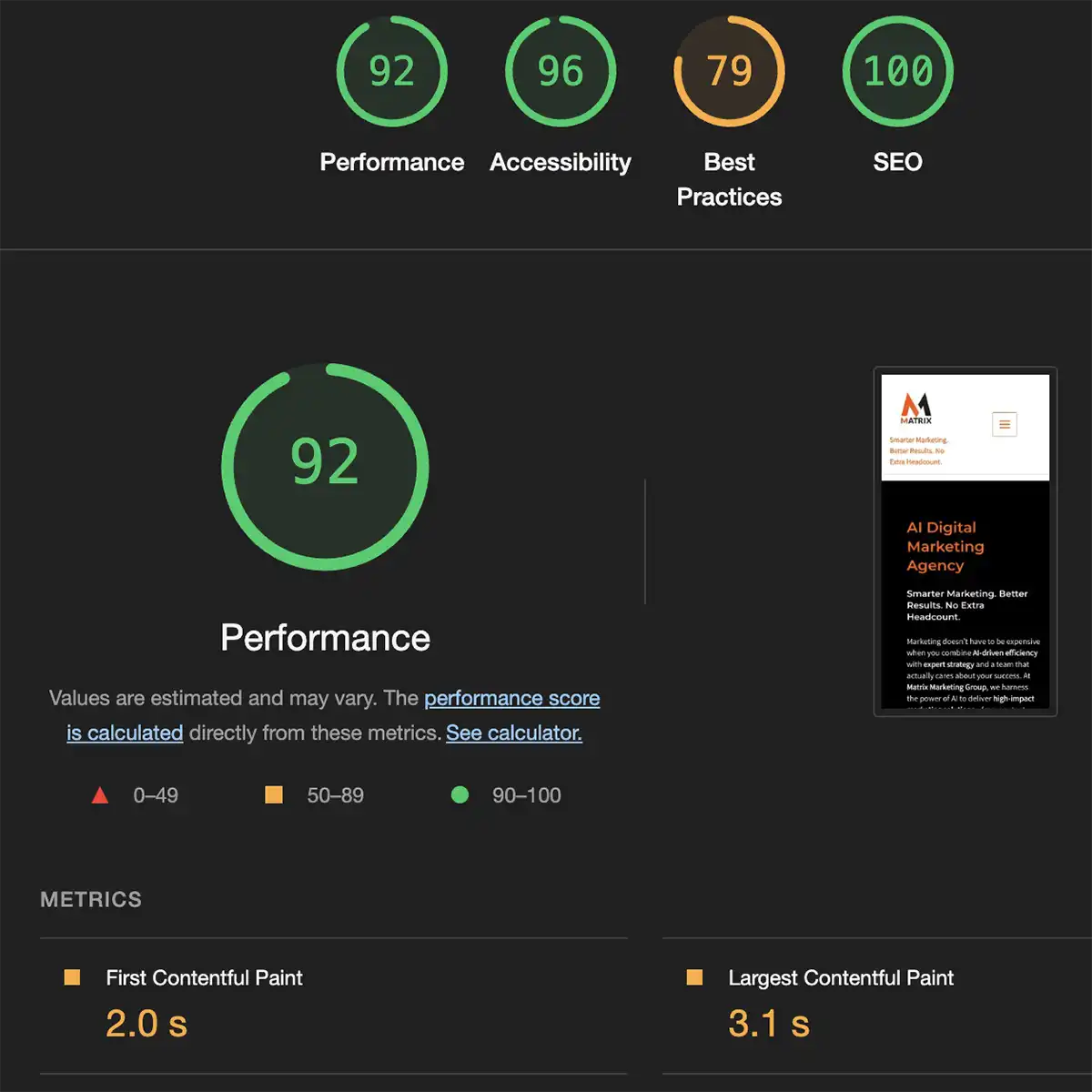Speculative Loading for Near-instant Page Loads
Learn About Speculative Loading for Near-instant Page Loads.
The Evolution of Web Search Speed: A Decade in Perspective
Imagine searching online just ten years ago. The average time to load a webpage was around 10 seconds, which, in today’s fast-paced digital environment, seems almost unbearably slow.
Fast forward to the present, and the situation has undergone a dramatic transformation, with page load times decreasing to under two seconds on average.
This quantum leap in speed not only enhances user satisfaction but also significantly affects the efficiency of online activities. This progress is largely attributable to innovative web technologies, one of which is Speculative Loading.
Absolutely! Here are some statistics from well-known SEO researchers about website speed and metrics, categorized by industry.
Website Speed Statistics and Metrics by Industry
General Speed Statistics
- Google Research: “53% of mobile site visitors leave a page that takes longer than three seconds to load.” This highlights the importance of fast mobile speeds across all industries.
- Backlinko (Brian Dean): “The average time it takes to load a mobile webpage fully is 15 seconds.” This indicates a significant gap between user expectations and actual performance, emphasizing the need for optimization.
- Akamai: “A 100-millisecond delay in website load time can hurt conversion rates by 7%.” This demonstrates the direct impact of speed on business outcomes, relevant to all sectors.
Industry-Specific Considerations
Manufacturing
- Metric: Time to First Byte (TTFB)
- Rationale: For manufacturing sites, providing technical documentation and product specifications quickly is crucial. TTFB measures the server’s responsiveness, indicating how fast the first piece of data is received.
- Statistic Implication: A fast TTFB ensures that users can access critical information without delays, improving trust and efficiency in B2B interactions.
Financial Services
- Metric: First Contentful Paint (FCP)
- Rationale: In financial services, quickly displaying key information like stock quotes or account balances is vital. FCP measures the time it takes for the browser to render the first piece of content, providing visual feedback to the user.
- Statistical Implication: A low FCP reduces perceived wait times, which are essential for maintaining user confidence and preventing frustration when accessing sensitive financial data.
E-commerce
- Metric: Largest Contentful Paint (LCP)
- Rationale: For e-commerce sites, loading product images and key content quickly is essential for conversions. LCP measures when the largest content element becomes visible, reflecting the overall loading experience.
- Statistic Implication: An optimized LCP minimizes the time users wait to see product details, reducing bounce rates and increasing the likelihood of purchases.
Understanding Speculative Loading

Speculative Loading is a cutting-edge web performance optimization technique that predicts the user’s next action and preloads resources accordingly.
This technology leverages machine learning algorithms and browser heuristics to anticipate what pages and resources a user might need next, even before the user makes the actual request.
By fetching necessary resources in advance, Speculative Loading can dramatically reduce perceived load times, making web browsing feel instant and seamless.
Speculative Loading operates on a simple yet powerful premise: if you can predict the future, you can prepare for it. As users interact with a webpage, their actions—such as mouse movements, clicks, and even scroll patterns—can provide clues about their next steps.
Using these cues, Speculative Loading intelligently preloads content that the user is likely to request. This preemptive action is a game-changer in web navigation, where every millisecond counts.
In an era where speed and efficiency are paramount, Speculative Loading emerges as a pivotal innovation in web technology.
This article examines how Speculative Loading enables near-instant page loads, thereby significantly enhancing the user experience and optimizing online performance.
Through a detailed examination of its mechanisms, impacts, and implications, we explore why Speculative Loading is not just a feature of the future but a necessity for any forward-thinking web initiative.
Speculative Loading for Near-Instant Page Loads: Understanding the Future of Web Performance

Who is it for?
Speculative loading is a game-changing technique designed for web developers, UX designers, and digital product managers who aim to enhance user experience by significantly reducing page load times.
Businesses seeking to enhance their online presence and retain visitors will also benefit from implementing this innovative approach.
What is it?
Speculative loading is a web performance strategy that anticipates user actions and preloads content before a user requests it.
By predicting the likely next steps a user will take, this technique enables websites to deliver near-instant page loads, resulting in a smoother browsing experience.
Instead of waiting for resources to load after a user clicks, speculative loading ensures that important elements, such as images or scripts, are already in the browser’s cache, thereby reducing the time it takes to load.
Where is it applied?
This technique is particularly valuable in e-commerce sites, news portals, and any fast-paced digital environment where user engagement is crucial.
Websites that demand instant feedback and a seamless user journey will find speculative loading to be an invaluable tool in their optimization toolkit.
How does it work?
Speculative loading works by leveraging predictive algorithms that analyze user behavior patterns. By understanding typical navigation paths, the system preloads essential resources as soon as a user visits a page.
For instance, if a user hovers over a link, the browser can begin loading the page’s resources in the background, drastically reducing the perceived load time.
Implementing speculative loading requires a combination of JavaScript techniques, server-side optimizations, and a strong focus on user analytics to predict user interactions accurately.
Speculative loading is crucial for any digital strategy aiming to improve performance, user satisfaction, and retention, while also providing a seamless browsing experience.
Imagine you’re hosting the biggest dinner party of the year. You’ve got guests who are incredibly diverse in their tastes and preferences. Instead of waiting for each guest to arrive and then starting to cook their favorite dish, you prepare a variety of popular dishes in advance.
As guests walk through the door, they are immediately greeted with tantalizing smells and an array of dishes ready to be savored, creating a delightful and instant experience for everyone.
This is exactly what Speculative Loading does for websites. Just as you anticipate the needs and preferences of your dinner guests, Speculative Loading anticipates what a user is likely to request next on a website.
By preloading resources and pages that the user is expected to visit, the website serves up content almost instantaneously, much like the ready-to-enjoy dishes at your dinner party.
This approach ensures that visitors remain engaged, satisfied, and impressed with the speed and fluidity of their browsing experience, just as your guests are with the instant feast laid out before them.
This technique is a game-changer in creating seamless and lightning-fast digital experiences, keeping users happy and engaged.
Challenges and Opportunities of Speculative Loading for Near-Instant Page Loads

Speculative loading, a technique designed to enhance web performance by preloading resources that a user is likely to need, presents both significant opportunities and inherent challenges.
In an era where user experience dictates engagement and retention, achieving near-instant page loads is a critical goal for developers and businesses alike.
This section examines the multifaceted nature of speculative loading, exploring its potential benefits and the challenges that must be overcome.
Opportunities
- Improved User Experience: Speculative loading can significantly reduce perceived loading times, resulting in a smoother and more satisfying user experience. By preemptively fetching resources, users are less likely to encounter loading indicators or delays, which can lead to higher engagement and lower bounce rates.
- Enhanced Performance Metrics: Fast-loading pages enhance key performance indicators, including time to first byte (TTFB) and time to interactive (TTI). Websites that implement speculative loading effectively can achieve better scores on performance monitoring tools, resulting in improved SEO rankings and increased visibility.
- Increased Conversion Rates: Studies show that even small reductions in loading times can lead to higher conversion rates. E-commerce platforms, for example, stand to benefit greatly from speculative loading, as a faster experience can encourage users to complete purchases rather than abandon their carts.
- Customization and Personalization: Speculative loading can leverage user behavior data to predict and preload content that is more likely to be relevant to specific users. This level of personalization can lead to increased user satisfaction and loyalty.
- Support for Emerging Technologies: As web technologies evolve, speculative loading can be paired with advancements such as service workers and progressive web apps (PWAs) to create seamless offline experiences, further enhancing the robustness of web applications.
Challenges
- Resource Overhead: One of the primary challenges of speculative loading is the potential for unnecessary resource consumption. Preloading resources that the user ultimately does not need can result in wasted bandwidth and increased data usage, which can be particularly problematic for users with limited or slow internet connections.
- Complex Implementation: Implementing speculative loading requires a careful balance between what to preload and what to defer. Overly aggressive preloading can lead to content being served out of order or create a jarring experience if the user navigates differently than anticipated.
- Increased Complexity in Development: Developers must account for the varying behavior of users, which can add complexity to the application logic. This complexity can lead to bugs and performance issues if not managed properly, making testing and maintenance more challenging.
- Impact on Browser Caching: Speculative loading can interfere with traditional caching mechanisms. If not designed properly, it may lead to cache thrashing, where resources are continuously loaded and unloaded, ultimately degrading performance rather than improving it.
- User Expectations: There is a risk that users may develop expectations for instantaneous loading times, leading to dissatisfaction if their experiences do not meet these heightened expectations. Managing user perceptions is critical when deploying speculative loading strategies.
Speculative loading presents a compelling opportunity to enhance web performance and user satisfaction, but it also poses its challenges.
By carefully considering the implications of this approach, developers can create innovative solutions that harness the power of preloading while mitigating its risks.
As the web continues to evolve, the importance of near-instant page loads will only increase, making speculative loading a vital area for exploration and development in creating fast, responsive, and user-centric web experiences.
Speculative Loading for Near-instant Page Loads
In the digital landscape, speed and user experience are paramount. Speculative loading is an innovative technique employed by brands to pre-load resources and content, anticipating user actions to ensure near-instant page loads.
Here are two case studies illustrating how companies have implemented speculative loading, the strategies they employed, and the lessons learned from their experiences.
Case Study 1: Amazon – Anticipating User Needs
Brand Description and Strategy
Amazon, the e-commerce giant, is renowned for its commitment to a seamless shopping experience.
Understanding that delays can lead to cart abandonment, Amazon’s initial strategy focused on reducing load times across its platform. To enhance the user experience, they aimed to predict user behavior, thus optimizing page load speeds.
Implementation of Speculative Loading
Amazon utilized speculative loading by pre-fetching product pages and resources based on users’ browsing patterns.
By analyzing past behavior, they identified common pathways users took when shopping.
For example, if a user spent time on a specific product page, the system would start loading the next likely pages in the background while the user remained on the current page.
This preemptive action drastically reduced load times when users clicked on the next product or category.
Mitigating Failures
During the initial rollout, Amazon encountered challenges where speculative loading sometimes resulted in unnecessary resource consumption, particularly for users who quickly left the site.
To address this, they implemented a more sophisticated algorithm that more accurately predicted user intent, thereby minimizing wasted bandwidth and server load.
They also included user settings to turn off pre-loading for those who preferred not to utilize this feature.
Lessons Learned
- Data-Driven Decisions: The success of speculative loading relies on robust data analytics to accurately predict user behavior.
- User Control: Providing users with options to opt in or out of speculative loading can enhance their satisfaction and trust.
- Continuous Optimization: Regularly refining predictive algorithms based on user interactions is crucial for maximizing efficiency and minimizing resource waste.
Case Study 2: Facebook – Enhancing User Engagement
Brand Description and Strategy
Facebook, the social media behemoth, continually strives to keep its users engaged.
With millions of posts and media shared every minute, ensuring that users can quickly view content is essential to maintaining user interest.
Initially, Facebook’s strategy involved improving the overall speed of its platform by implementing various loading techniques, including speculative loading.
Implementation of Speculative Loading
Facebook’s approach to speculative loading involved preloading content, such as images and videos, as users scrolled through their feeds.
By anticipating which posts users were likely to engage with next based on scrolling behavior, Facebook began loading these assets in advance.
This resulted in a seamless scrolling experience where content appeared almost instantly as users moved through their feeds.
Mitigating Failures
Facebook encountered a scenario where speculative loading led to users seeing content that was not immediately relevant, which sometimes resulted in a negative user experience.
To combat this, Facebook developed machine learning models that more accurately predicted user interests and preferences, ensuring that only relevant content was pre-loaded.
They also monitored user feedback closely to identify any dissatisfaction related to this feature.
Lessons Learned
- Personalization is Key: Effective speculative loading relies on understanding user preferences and behaviors, which necessitates a focus on personalization.
- Feedback Loops: Implementing mechanisms for user feedback can provide valuable insights into how speculative loading is impacting the user experience.
- Balancing Speed and Relevance: Prioritizing speed should not compromise the relevance of content. Balancing is essential to maintain user satisfaction.
The case studies of Amazon and Facebook highlight the significant benefits of speculative loading in enhancing page load speeds and improving user experience.
Through careful planning, data-driven strategies, and ongoing optimization, brands can leverage speculative loading effectively while mitigating potential pitfalls.
These insights serve as a guide for companies looking to implement similar strategies in their digital environments.
Super Fast Speculative Loading
Matrix Marketing Group is at the forefront of innovation in digital marketing. Our services align perfectly with the insights presented in the article, “Speculative Loading for Near-instant Page Loads.”
As businesses increasingly strive for faster, more efficient online experiences, Matrix Marketing Group leverages advanced AI-driven techniques to enhance website performance and user engagement.
Speculative loading is a cutting-edge approach that anticipates user actions and preloads content, significantly reducing waiting times and improving user satisfaction.
This methodology complements Matrix Marketing Group’s suite of AI digital marketing services, which include predictive analytics, personalized content delivery, and real-time optimization.
By integrating speculative loading into their strategies, Matrix Marketing Group ensures that websites not only load swiftly but also provide a seamless experience tailored to individual user needs.
The convergence of AI technology and speculative loading offers a transformative advantage in the competitive digital landscape. As consumers demand instant gratification, Matrix Marketing Group empowers businesses to meet and exceed these expectations.
By focusing on speed and efficiency, they help brands capture attention, enhance user retention, and ultimately drive conversions. In essence, Matrix Marketing Group stands as a leader in marrying innovative techniques with practical digital marketing solutions, ensuring clients remain ahead in a fast-paced digital world.
In Conclusion
Speculative loading represents a transformative approach to web performance, enabling near-instant page loads that significantly enhance user experience.
By anticipating user actions and preloading content, developers can reduce perceived latency and create a seamless browsing journey.
We explored the principles behind speculative loading, the technical implementations, and the positive impacts on engagement and retention rates.
The main takeaway is clear: as user expectations for speed continue to rise, adopting speculative loading techniques is not just an advantage; it has become a necessity for modern web applications.
As we move forward, consider how speculative loading could be integrated into your digital strategy. What user behaviors can you anticipate, and how can you leverage this innovative technique to elevate your website’s performance?
Embrace the challenge of optimizing user experience, and lead your digital presence into the future of near-instant interactions.
The time to act is now—your users are waiting.
AI Playbook Selector by Industry
Find Your AI Marketing Playbook
Pick your industry → go straight to your tailored AI Playbook.


